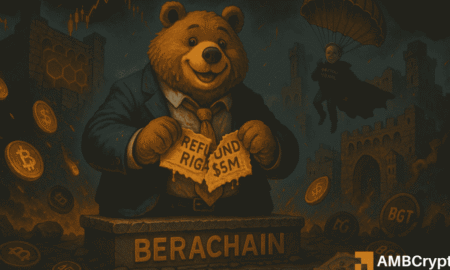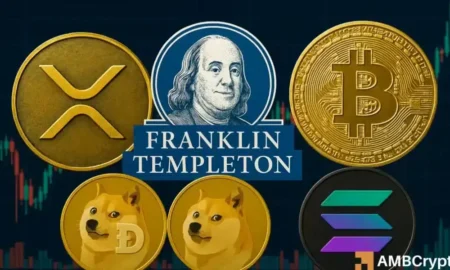Title: The Rise of Tokenization: Transforming Financial Markets for Major Institutions
In recent years, significant shifts have occurred in the financial landscape, especially regarding digital assets. According to data from Bitwise, approximately 83% of the largest global financial institutions now offer at least one form of digital asset service. While initial activities concentrated around trading desks, custody solutions, and crypto Exchange Traded Products (ETPs), a new avenue has emerged: tokenization. This transformative practice is proving to be instrumental in reshaping how financial assets move, settle, and generate liquidity. Understanding the significance of tokenization is essential for grasping the future of finance.
Tokenization refers to the process of converting rights to an asset into a digital token on a blockchain. This emerging technology represents a fundamental shift in how various financial products are managed. Institutions like Goldman Sachs, JPMorgan, Deutsche Bank, and even the London Stock Exchange are at the forefront of this change, integrating tokenization into their services. The projections for growth in tokenized assets are staggering; estimates suggest that the tokenized asset market could surge from $0.6 trillion in 2025 to nearly $19 trillion by 2033. This dramatic increase underscores the importance of tokenization in the long-term strategies of financial institutions.
One of the primary advantages of tokenization lies in its potential to solve long-standing inefficiencies in traditional financial systems. Tokenizing real-world assets (RWAs) such as bonds, real estate, and credit products makes transactions more efficient. Conventional processes involve lengthy settlement times, multiple intermediaries, and cumbersome manual checks. In contrast, tokenized transactions can be executed swiftly and at a reduced cost, providing substantial efficiency gains for institutions handling substantial transaction volumes daily. These enhancements resonate well within institutional frameworks, where even marginal improvements can lead to notable financial savings.
Tokenization also facilitates fractional ownership, allowing assets to be divided into smaller, tradable units without altering their core attributes. This characteristic opens doors to broader distribution and more flexible product designs, catering to diverse investor types. For example, a tokenized treasury bill can be segmented into smaller pieces, promoting liquidity and access to a wider base of potential investors. Furthermore, tokenized assets can be traded continuously across global platforms, overcoming the constraints of traditional market hours. This capability enhances liquidity, a factor that institutions value as it mitigates risks and maximizes capital efficiency.
The long-term implications of tokenization extend beyond mere trading convenience. It has the potential to unify capital markets, moving them away from the fragmented, jurisdiction-bound systems of today. This evolution can significantly streamline processes involved in issuance and settlement, ultimately reducing costs while enhancing transparency and compliance. As institutions adopt tokenized methods, the issuance of assets like bonds and private credit instruments could also be revolutionized. The transition toward programmable issuance promises a quicker, more accessible process for a global investor base, enabling institutions to leverage blockchain technology for greater operational efficiency.
Despite the momentum surrounding tokenization, several obstacles must be navigated before it can become the standard in global finance. Interoperability remains a significant challenge; diverse blockchain systems, both public and private, often struggle to communicate. Avoiding fragmentation is vital, as traditional finance (TradFi) already faces these hurdles. Regulatory frameworks are another critical factor; many jurisdictions continue to grapple with integrating tokenized assets into existing securities laws and investor protections. Without clearer, consistent guidelines, institutions remain hesitant to scale these products.
Custody models are also evolving in response to the rise of tokenization. Managing tokenized assets poses distinct challenges compared to traditional securities storage. Institutions require secure and familiar infrastructure that blends blockchain-native tools with established safeguards. Addressing these requirements will be instrumental as the industry transitions toward a more tokenized environment. Despite these hurdles, they are not insurmountable. Institutions and regulatory bodies that successfully address interoperability, establish clear regulations, and develop reliable custody solutions will likely lead the charge in this new era. Competitors that fail to adapt will find themselves playing catch-up in a rapidly evolving financial ecosystem.
In summary, tokenization is emerging as a game-changing force in finance, attracting the attention of major global institutions. As the tokenized asset market is projected to experience exponential growth, institutions are recognizing its potential to solve long-standing inefficiencies, enhance liquidity, and transform how assets are issued and settled. While challenges remain, the institutions that navigate these issues effectively will position themselves as leaders in the adopting tokenization era. The future of finance is on the horizon, and tokenization is poised to drive that change.
















![Plasma [XPL] Declines After Airdrop Surge – Has the Hype Around the ‘New Chain’ Faded?](https://icoinmarket.com/wp-content/uploads/2025/11/Lennox-1-6-1000x600-450x270.png)